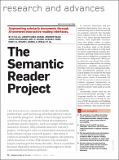| dc.contributor.author | Lo, Kyle | |
| dc.contributor.author | Chang, Joseph | |
| dc.contributor.author | Head, Andrew | |
| dc.contributor.author | Bragg, Jonathan | |
| dc.contributor.author | Zhang, Amy | |
| dc.contributor.author | Trier, Cassidy | |
| dc.contributor.author | Anastasiades, Chloe | |
| dc.contributor.author | August, Tal | |
| dc.contributor.author | Authur, Russell | |
| dc.contributor.author | Bragg, Danielle | |
| dc.contributor.author | Bransom, Erin | |
| dc.contributor.author | Cachola, Isabel | |
| dc.contributor.author | Candra, Stefan | |
| dc.contributor.author | Chandrasekhar, Yoganand | |
| dc.contributor.author | Chen, Yen-Sung | |
| dc.contributor.author | Cheng, Evie | |
| dc.contributor.author | Chou, Yvonne | |
| dc.contributor.author | Downey, Doug | |
| dc.contributor.author | Evans, Rob | |
| dc.contributor.author | Fok, Raymond | |
| dc.date.accessioned | 2024-10-15T21:15:04Z | |
| dc.date.available | 2024-10-15T21:15:04Z | |
| dc.date.issued | 2024-10-01 | |
| dc.identifier.issn | 0001-0782 | |
| dc.identifier.uri | https://hdl.handle.net/1721.1/157322 | |
| dc.description.abstract | Scholarly publications are key to the transfer of knowledge from scholars to others. However, research papers are information-dense, and as the volume of the scientific literature grows, the greater the need for new technology to support scholars. In contrast to the process of finding papers, which has been transformed by Internet technology, the experience of reading research papers has changed little in decades. For instance, the PDF format for sharing papers remains widely used due to its portability but has significant downsides, inter alia, static content and poor accessibility for low-vision readers. This paper explores the question "Can recent advances in AI and HCI power intelligent, interactive, and accessible reading interfaces, even for legacy PDFs?" We describe the Semantic Reader Project, a collaborative effort across multiple institutions to explore automatic creation of dynamic reading interfaces for research papers. Through this project, we've developed a collection of novel reading interfaces and evaluated them with study participants and real-world users to show improved reading experiences for scholars. We've also released a production research paper reading interface that will continuously incorporate novel features from our research as they mature. We structure this paper around five key opportunities for AI assistance in scholarly reading---discovery, efficiency, comprehension, synthesis, and accessibility---and present an overview of our progress and discuss remaining open challenges. | en_US |
| dc.publisher | ACM | en_US |
| dc.relation.isversionof | http://dx.doi.org/10.1145/3659096 | en_US |
| dc.rights | Creative Commons Attribution | en_US |
| dc.rights.uri | https://creativecommons.org/licenses/by/4.0/ | en_US |
| dc.source | Association for Computing Machinery | en_US |
| dc.title | The Semantic Reader Project: Augmenting Scholarly Documents through AI-Powered Interactive Reading Interfaces | en_US |
| dc.type | Article | en_US |
| dc.identifier.citation | Lo, Kyle, Chang, Joseph, Head, Andrew, Bragg, Jonathan, Zhang, Amy et al. 2024. "The Semantic Reader Project: Augmenting Scholarly Documents through AI-Powered Interactive Reading Interfaces." Communications of the ACM, 67 (10). | |
| dc.relation.journal | Communications of the ACM | en_US |
| dc.identifier.mitlicense | PUBLISHER_CC | |
| dc.eprint.version | Final published version | en_US |
| dc.type.uri | http://purl.org/eprint/type/JournalArticle | en_US |
| eprint.status | http://purl.org/eprint/status/PeerReviewed | en_US |
| dc.date.updated | 2024-10-01T07:45:43Z | |
| dc.language.rfc3066 | en | |
| dc.rights.holder | The author(s) | |
| dspace.date.submission | 2024-10-01T07:45:45Z | |
| mit.journal.volume | 67 | en_US |
| mit.journal.issue | 10 | en_US |
| mit.license | PUBLISHER_CC | |
| mit.metadata.status | Authority Work and Publication Information Needed | en_US |
